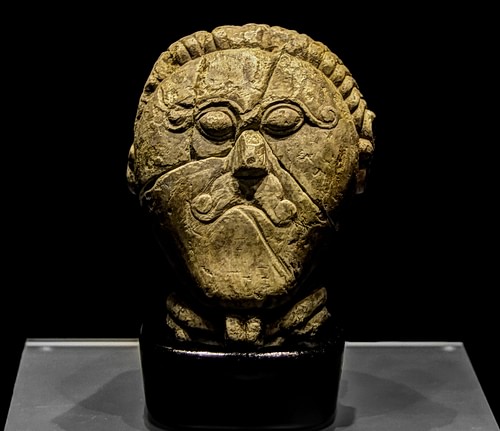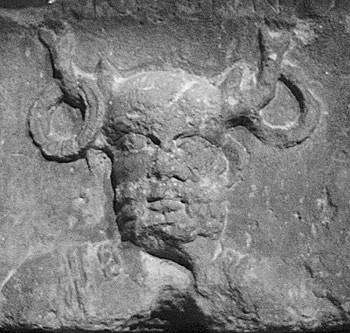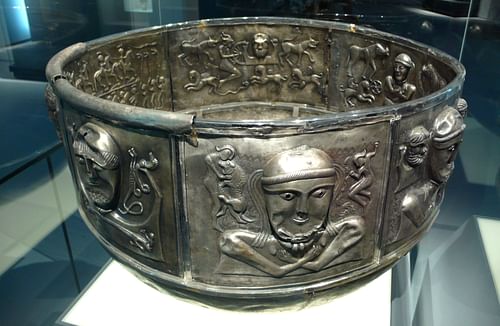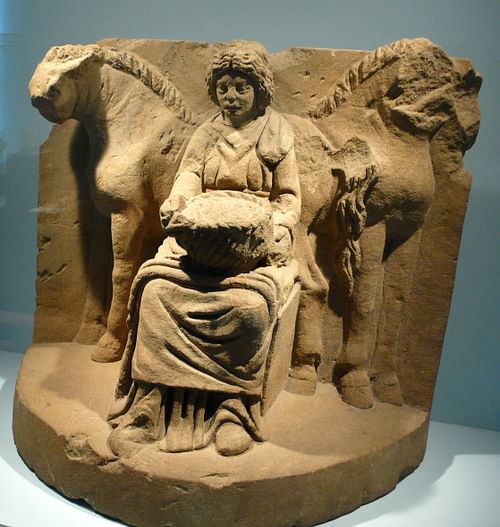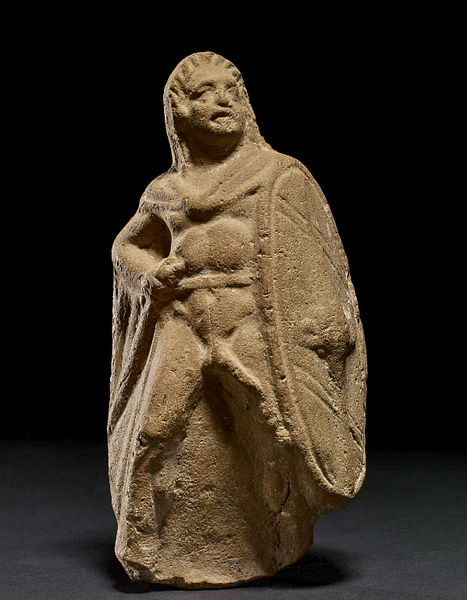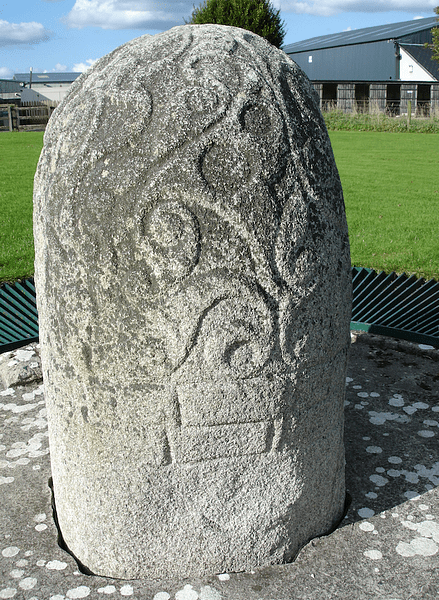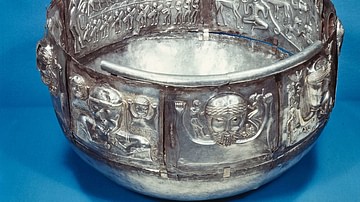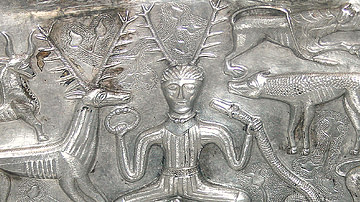The ancient Celtic pantheon consisted of over 400 gods and goddesses who represented everything from rivers to warfare. With perhaps the exception of Lugh, the Celtic gods were not universally worshipped across Iron Age Europe but were very often limited to only several regions or a specific area. Another difficulty in examining the Celtic pantheon is the paucity of written records produced by the Celts themselves; quite often a god (deivos/deiva) is named in only a single surviving inscription. To further complicate our lack of knowledge, the Celts often gave all-embracing powers and attributes to their gods which means that they can rarely be easily categorised like, say, the Greek Poseidon or Roman Mars. Nevertheless, by piecing together secondary accounts by Classical authors, the work of early Christian writers, Celtic artefacts, and archaeological investigations, we can build a reasonable picture of at least some of the vast number of deities the ancient Celts worshipped, a pantheon that the Celtic historian Proinsias MacCana described as a ‘fertile chaos’.
Celtic votive inscriptions from the Roman period often name a Celtic god with a Roman equivalent noted alongside, a practice known as the interpretatio romana, and this association is noted in the relevant entries below. The entries are generally restricted to only the major deities or those with multiple or significant inscriptions.
Abnoba - a hunting goddess venerated in the Black Forest region in southeast Germany and sometimes associated with the Roman huntress goddess Diana. Various votive inscriptions mention the goddess across southern Germany. A sandstone figurine of the goddess survives from Karlsruhe-Mühlburg in southeast Germany where she is shown wearing a Greek chiton and accompanied by a hunting dog who has captured a hare.
Aeracura - a goddess worshipped in parts of the Roman Empire and often associated with the Underworld god Dis Pater. No written records reveal any information about her.
Agrona - a goddess associated with slaughter in battle and venerated in Britain.
Ahes - a goddess credited with building the Roman roads in Brittany and considered a patroness of roads.
Alator - identified by the Romans as the equivalent of their god of war Mars. He is mentioned in an altar from South Shields and a votive slab from Barkway, both in England. The latter depicts the god as a warrior with a shield, helmet, and spear.
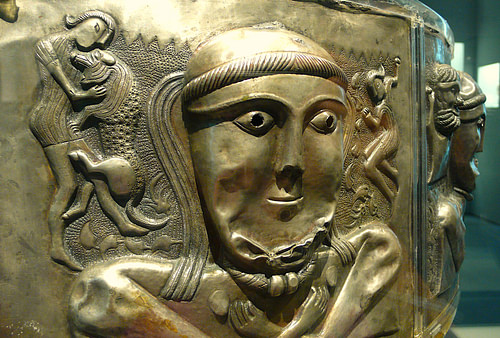
Albiorix - his name likely derives from Alba or Albu (Albion to the Romans), the ancient name of Britain. Equated with Mars, an inscription naming him survives from Sablet in what is today the Languedoc region of France.
Alisonus (also Alisanos) - a god associated with rocks or rocky outcrops, possibly connected to the oppidum of Alesia in Gaul or the river Alisos. He is mentioned in votive inscriptions on two bronze dishes found in east-central France.
Amarcolitanus - his name may mean 'he of the distant gaze', and he was identified with Apollo by the Romans. A votive inscription survives from Branges in eastern France.
Ancamna - a goddess who is the partner of the gods Lenus and Smertrius in several inscriptions.
Andarta - a Celtic goddess whose name may derive from the Celtic word for the bear animal. Seven votive inscriptions naming the goddess survive from Die in southern France.
Andrasta - a Celtic goddess known only from a single reference by the Roman writer Cassius Dio (c. 164 - c. 235 CE). He records that Boudicca (d. 61 CE), queen of the Iceni in Britain, called upon the help of Andrasta when there was a tribal uprising in 61 CE. Hares were sacrificed to Andrasta.
Anextlomarus - a god whose name likely means 'great protector'. Another god equated with Apollo, he is mentioned in inscriptions from northern Britain and northern France. In a third location, Aventicum (Avenches) in Switzerland, an inscription has the name spelt Anextlomara.
Antenociticus (also Anociticus or Antocidicus) - the name of a youthful god who was worshipped at three altars near Hadrian’s Wall in northern Britain. At the same site, parts of a statue of Antenociticus were discovered, which include the head where his hair resembles the horns of a young stag.
Anu (also Ana or Anann) - a major pre-Christian era goddess in Ireland. In the Glossary of Bishop Cormac, the goddess is referred to as the mother of all the Irish gods. Associated with fertility, Anu was especially revered in Munster although in epic poetry the whole of Ireland is sometimes referred to as the 'Land of Anu'.
Arduinna - a boar-goddess associated with mountains near the forest of the Rhine. She is linked to Diana by the Romans in votive inscriptions. She may well be depicted in a bronze statue of a goddess riding a boar of unknown provenance.
Arecurius - a god venerated in northeast England during the Roman period whose name means 'he who stands before the tribe'.
Arnemetia - a name of a goddess referred to in an inscription found at a sacred spring near Buxton, Derbyshire, England, and another from an altar in the Roman fort of Brough-on-Noe in the same county. In the latter inscription, the goddess’ name is Arnomecte.
Artaius - a god identified with Mercury by the Romans. His name may derive from the Celtic word for the bear animal. An inscription naming the god survives from Beaucroissant in southeast France.
Artio - another goddess whose name derives from the Celtic word for 'bear'. An inscription survives on a 20 cm (7.8 in) tall bronze figurine of the goddess discovered at Muri, near Berne, Switzerland. The goddess is depicted in a seated position, and she is offering a bowl of fruit to a bear. Another inscription naming the goddess was found near Trier in western Germany.
Arvernorix - a god identified with Mercury by the Romans whose name translates as 'King of the Averni', the tribe in the Auvergne region of central France. Only one inscription mentions the god by name and comes from near Miltenberg in Bavaria, Germany.
Arvernus - a god identified with Mercury by the Romans who may be a variation of Arvernorix. However, all of the written evidence of the god’s cult comes from the banks of the Rhine in Germany.
Atepomarus - a god identified with Apollo by the Romans. A votive inscription survives from Mauvières in central France.
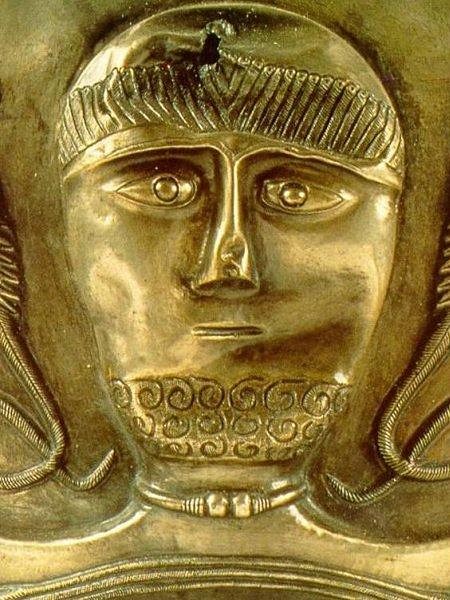
Atesmerius - a god worshipped by the Meldi tribe in the lower Marne region of northeast France. An inscription survives from the Meldi capital at Meaux and another from Poitiers in western France where he is called Adsmerius. To further confuse the naming of this deity, an inscription of a goddess called Atesmerta survives from the Corgebin forest in the Marne region.
Barrex (Barrecis) - a god identified by the Romans with their god Mars and whose name survives in an inscription from Carlisle, northern England.
Belatucadrus - a god attested by a large number of inscriptions from northern England, often identified with the Roman god of war, Mars. His name is spelt in various ways on these inscriptions, perhaps suggesting he was particularly venerated by the lower classes (who had a lower level of literacy).
Belenus (also Belinus, Bel, Belus, or Belinu) - a major god whose name likely derives from the Celtic for 'light' or 'to shine' and who is referred to in both literature and inscriptions of all kinds, including an engraved gemstone. He was known in various parts of Celtic Europe but especially in southern France, northern Italy, and the eastern Alps. A high concentration of inscriptions naming the god has been found at Aquileia in northern Italy. Identified with Apollo by the Romans, he was likely regarded as the protector god of Celts living in northeast Italy. He is also mentioned in inscriptions as far south as Rimini and Rome and was associated with health-giving springs.
Belisama (also Belesama or Belisma) - a goddess associated with lakes and rivers whose name means 'bright one' or 'the most shining'. A votive inscription naming the goddess survives from near Orange in southern France. The inscription is written in the Greek alphabet and describes the dedication of a shrine to Belisama by one Segomaros, a Gaul from Nîmes. The Romans often identified the goddess with Minerva, and her name is the origin of many place names in France.
Bergusia - a goddess, possibly a patron of crafts, whose name is mentioned in an inscription from Alesia, chief settlement of the Mandubii tribe in eastern Gaul. She is the consort of the god Ucuetis.
Boand (also Boann, Boin, or Boinne) - a pre-Christian goddess who represented the Boyne River in eastern Ireland.
Bodb (also Badb or Bave) - The name in the Irish Mythological Cycle of both the son of the Dagda and a female battle demon who typically takes the form of a crow on the battlefield.
Bodua - a war goddess venerated in Gaul.
Bolvinnus - a god identified with Mars by the Romans and named in two votive inscriptions from Bouhy in central France.
Bormana - a goddess who is sometimes the consort of Borvo.
Borvo (also Bormo) - a god whose name likely derives from the Celtic word meaning 'to boil' and so indicates his frequent association with natural hot springs. Votive inscriptions have survived at two spring sites, both named after the god: Bourbon-Lancy and Bourbonne-les-Bains in central and eastern France respectively. He is also mentioned further afield but with different spellings, for example, Bormanus and Bormana in other parts of France and Bormanicus in Portugal. His consort in several inscriptions is the goddess Damona or Bormana. The Romans equated him with Apollo.
Braciaca - a god mentioned in one votive inscription from central England which identifies him with the Roman god of war Mars.
Brigantia - a goddess whose name means 'the sublime one' and who the Romans equated with the goddess Victory. She was particularly venerated in northern England from where several votive inscriptions survive. A unique inscription equates the goddess with Caelestis, an African goddess, while a relief from southern Scotland depicts Brigantia with mural crown and wings, associations of Minerva and Victory respectively. She may have been known as Brigindo in eastern Gaul.
Brigit - a goddess in pre-Christian Ireland who was a daughter of the Dagda. She was particularly venerated by poets, although she was also considered to have skills in healing, metalwork, and poetry. Very likely, she derives from the older British goddess Brigantia.
Britovius - identified with Mars by the Romans and mentioned in votive inscriptions from Nîmes in southern France.
Brixia (also Bricta) - a goddess of continental Europe of unknown significance, she may have had, as the consort of Luxovius, an association with water.
Budenicus - a god the Romans equated with Mars who is mentioned in only a single votive inscription from near Uzès in southern France.
Bussumarus - a god venerated in continental Europe who the Romans equated with their Jupiter.
Buxenus - a god the Romans equated with Mars and who is mentioned in only a single votive inscription from near Velleron in southeast France.
Camulus - a god venerated across Celtic Europe as attested by surviving votive inscriptions from Rome, Rheims in northern France, Br Hill in Scotland, Arlon in southern Belgium, Rindern and Mainz in western Germany. In most inscriptions, he is identified with the Roman god Mars. One carved stone bearing his name from Rindern is decorated with a crown of oak leaves and depictions of him often give the god ram's horns. He gave his name to Roman Colchester - Camulodunum - in southeast England.
Canomagus - a god of hounds named with Apollo on a votive inscription from Nettleton Shrub in southwest England.
Cathubodua - a war-goddess venerated in Gaul who is mentioned in a votive inscription from Haute Savoie in eastern France.
Caturix - a god whose name means 'king of battle' and identified by the Romans with their god of war, Mars. Votive inscriptions naming Caturix have been found across Roman Switzerland and in Böckingen in southern Germany.
Cernunnos - a horned god who represented nature, flora and fauna, fertility, and prosperity. He is frequently depicted in Celtic art across Europe and also Gallo-Roman art with horns or stag antlers. He is given human form but he may have animal legs and hooves. Frequently, he is shown seated cross-legged. His name may derive from the Celtic word for 'horn' or 'antler', but this is disputed amongst scholars. He is shown and named on the Nautae Parisiaci (first half of the 1st century CE), a votive pillar dedicated to the Roman god Jupiter and discovered beneath Notre-Dame cathedral in Paris. He is also famously depicted on the Gundestrup Cauldron (perhaps 1st century BCE) where he again wears torcs. He is the origin of the cultural hero Conall Cernach of the Ulster Cycle and perhaps one of the inspirations in the visualisation of Satan in Christian art.
Cicollus - a god whose name likely means 'Great Protector' and who was identified with Mars by the Romans. His consort is often Litavis. Cicollus is named in altar inscriptions discovered at Dijon, Mâlain, and Aignay-le-Duc, all in eastern central France. His veneration further afield is attested by an inscribed metal circlet from Windisch in northern Switzerland.
Cissonius - a god the Romans identified with Mercury. His name survives in at least ten votive inscriptions.
Cnabetius - a god whose name perhaps means 'the Crippled One'. The Romans identified him with Mars, and votive inscriptions survive from Hüttigweiler, Tholey, Wahlscheid in western Germany, and Erbstetten and Osteburken in southern Germany.
Cocidius - a god venerated in northern England, especially by members of the Roman army. Inscriptions identify him with the Roman god of war, Mars, the Roman god of woods, Silvanus, and the Celtic god Vernostonus (of which nothing is known). He is shown as a huntsman accompanied by a hunting dog and stag in an altar relief and as a warrior with a spear and shield on two silver votive plaques, all from England. He may have horns or wear a hooded cloak.
Condatis - a god whose name implies he was associated with the confluence of two rivers. Many settlements in Gaul built at such places were called Condates. Several surviving inscriptions reveal that he was venerated in northeast England, particularly at shrines between the rivers Tyne and Tees. He is identified with the Roman god Mars.
Contrebus - a god whose name means 'he who lives amongst us' and who is mentioned in a votive inscription from northwest England.
Corotiacus - only a single votive inscription from Martlesham, Suffolk, England names the god, who the Romans equated with Mars.
Cososus - he is identified with the Roman god Mars and is named in a votive inscription from Bourges in central France.
Coventina - a goddess who had a sanctuary dedicated to her near Hadrian’s Wall. The goddess is represented as a water-nymph reclining on a leaf in one votive relief plaque from the site. Another relief shows three nymphs, each holding a vessel and pouring from it water, a typical triplication of deities seen in Celtic religious art. Other votive offerings discovered at the sanctuary include bronze animal figurines, pottery vessels, and over 14,000 coins, most of which were deposited into a well, which was presumably associated with the goddess.
The Dagda - an Irish-Celtic god whose name is usually preceded by the definite article. His name likely means 'the good god', probably in the sense of being 'many-skilled'. His common attributes are a great club, which can both kill and bring the dead back to life, and a giant cauldron that can produce an inexhaustible quantity of food, especially porridge. In Irish Mythology, the Dagda appears as a multi-talented warrior-leader of the Tuatha Dé Dannan, invaders of ancient Ireland who won battles against the resident Fir Bolg and against the seafaring Fomorians. The Dagda was important during the festival of Samhain on 31st October/1st November when he coupled with the demon goddess the Mórrigan, which guaranteed fertility and prosperity for the coming year.
Damona - a goddess whose name may derive from the Celtic word for 'cow'. She is the consort of the god Borvo in several inscriptions from Gaul. In a single inscription from northeast France, she is the consort of a god called Albius. A third partner, Moritasgus, is identified by name on the remains of a statue of Damona from Alesia.
Danu (also Dana) - a Celtic mother-goddess who gives her name, which means 'stream' or 'the waters of heaven' to various places and the River Danube.
Daron - an obscure goddess venerated in Britain and associated with the oak tree.
Deva - the Roman name of a goddess venerated in Britain who gave her name to the River Dee in northern Wales and southwest England.
Dinomogetimarus - a god who is named (along with Divanno) in an inscription from Saint-Pons in southern France. He was identified with the Roman god Mars.
Divanno - a god who is named (along with Dinomogetimarus) in an inscription from Saint-Pons in southern France. He was identified with the Roman god Mars.
Dumiatis - a god whose cult is indicated by a bronze votive plaque from a hilltop Gallo-Roman temple near Clermont-Ferrand in central France. He was identified with Mercury by the Romans.
Eochaid - a sun god venerated in pre-Christian Ireland and associated with lightning and horses.
Epona - a major goddess whose name derives from the Celtic word for 'horse' and so she was likely regarded as a protectress of this animal, an important one in Celtic culture, as well as mules and donkeys. Epona was venerated in various parts of Celtic Europe as attested by over 60 votive inscriptions discovered from Iberia to the Balkans. A great number of images of the goddess have survived and typically portray her either riding a horse (side-saddle) or sitting on a throne holding a bowl or cornucopia (horn of plenty) with a horse stood on either side. She is sometimes accompanied by a foal, bird, or dog. Epona is mentioned by various 1st- and 2nd-century CE Roman writers, including Apuleius who describes a statue of Epona festooned with roses and set up in a stable.
Ernmas - the mother of the war/demon goddesses Bodb, Macha, and the Mórrigan in the Irish Mythological Cycle. Her name refers to the idea of death from weapons.
Erriapus - a local god venerated in southern Gaul. A sculpture of the god's head was found in the Garonne region where he is surrounded by foliage.
Esus - a god who was venerated across Gaul but who is mentioned in only a few inscriptions by name, notably on the 1st-century CE Nautae Parisiaci votive monument found beneath Notre-Dame cathedral in Paris. On the same monument, he is depicted in relief as a bearded man next to a tree. He is wearing the clothes of an artisan and holds a sickle with which he is cutting off branches of a tree. Next to this scene is a bull and three cranes, which perhaps refers to a particular myth involving Esus which has now been lost. Esus is mentioned by Roman writers as a recipient of human sacrifices, the particular method being to hang the victim until their limbs are separated from the torso.
Fagus - a god associated with the beech tree.
Gebrinius - a Celtic god who may be Germanic in origin. Inscriptions naming him were discovered under the cathedral of Bonn. Identified with Mercury by the Romans.
Genii Cucullati - mysterious Celtic divinities which are not given a name but appear in groups or alone and wear hooded cloaks in art. Depictions typically have them near a single better-known god and holding either an egg or a scroll.
Glanis - a healing-spring god venerated at a shrine in Glanum in southern Gaul. He may have been part of a triad of gods known as the Glanicae.
Grannus - a god considered to have healing powers and equated with Apollo by the Romans. He is often called Apollo-Grannus in inscriptions which have been found in the Netherlands, Spain, Germany, France, and Hungary. He had several sanctuaries dedicated to him across the Celtic world. His consort was Sirona, and votive dedications have been discovered which were made to the two gods as a pair.
Icuana - a goddess associated with the river Yonne, a tributary of the River Seine. She is named in a now lost Roman-period votive inscription found in Auxerre in north-central France.
Intarabus - an unknown god equated with Mars by the Romans. Inscriptions naming him survive from Trier in western Germany and Foy in Belgium.
Iovantucarus - a god whose name means 'he who loves youth' and so he was perhaps a protector of children or patron of adolescents. He is identified with the Roman god Mars in multiple inscriptions from Trier but with Mercury in an inscription from near Tholey, both in western Germany. Unusually, he is named on a silver ring from Heidenburg, also in western Germany.
Latobius - a god known only by inscriptions, some of which come from Noricum (Austria), and the remains of a colossal statue.
Leherennus - perhaps a pre-Celtic god, his votive inscriptions concentrate around Ardiège in southwest France. He is equated with Mars by the Romans.
Lenus - a god whose veneration is attested by votive inscriptions from Trier, Caerwent (southern Wales) and Chedworth (southwest England). He is equated with Mars by the Romans. A relief from Chedworth depicts Lenus carrying a spear and an axe.
Leucetius (also Loucetius) - a god whose name means 'to shine', votive inscriptions survive from sites in western Germany, Strasbourg in eastern France, and Bath in southwest England. He is equated with Mars by the Romans.
Litavis - a goddess whose name may mean 'earth' or 'broad'. Several votive inscriptions survive from northeast France. She is the consort of Cicollus and is equated with Mars by the Romans.
Lugus (also Lugos, Logos, or Lugh) - a Celtic god who remains obscure until medieval sources expand upon his associations. The god gave his name to many place names such as Lugdunum, modern Lyon in southeast France. He may be the god that Julius Caesar describes as the supreme Celtic god, but scholars are not all in agreement on this point. He represents the sun and light and was regarded as an all-wise and all-seeing deity. In later mythology, he becomes the great warrior and Irish cultural hero who is often given an epithet such as Lugh Lámfada (or Lámfhota), meaning long-armed or 'of the long hand', which refers to his prowess with throwing weapons, or Lugh Samildánach, meaning 'skilled in many arts and crafts'. He leads the Tuatha Dé Danann race to victory against the seafaring Fomorians at the Battle of Mag Tuired and kills one-eyed Balor with his magic spear or sling to establish a 40-year reign of peace and prosperity.
Luxovius - a water god venerated in Luxeuil in eastern France where there is a natural spring. His consort is Brixia.
Macha - a demon/war goddess who is the sister (or alternative aspect) of the Mórrigan and Bodb, both of whom are also demon/war goddesses in the Irish Mythological Cycle. She is the daughter of the Dagda.
Maponus (also Maponas) - a god whose name means 'son' or 'child'. He is mentioned in votive inscriptions from northern England and the famous lead tablet from Chamalières in central France. He is identified with Apollo by the Romans. During the Roman period the god is depicted, like Apollo, holding a lyre and so he is associated with music and poetry.
Matrona - a mother-goddess associated with the Marne river and named in votive inscriptions from northeast Gaul.
Matronae (also Matres or Martrae) - a triad of mother-goddesses venerated across central Celtic Europe and typically shown as a trio of deities who hold such items as flowers, baskets of fruit and ears of wheat, or hold infants, all of which remind of their association with fertility and abundance.
Matunus - a god whose name derives from the Celtic word for the bear animal and who is named in a single votive inscription from northern England.
Medb (also Maeve) - perhaps an ancient goddess of sovereignty who became better known in later Irish mythology as the wife of Ailill, king of Connacht in the Ulster Cycle.
Medocius - a god named in a votive inscription from Colchester in southeast England. The Romans equated Medocius with their god of war, Mars.
Moccus - a god whose name is perhaps related to the Celtic word for 'pig'. He is mentioned by name in a votive inscription from Langres in northeast France and may have been the protector of boar hunters. The Romans equated him with their god Mercury.
Mogetius - a god mentioned by name in votive inscriptions from Bourges and Seggau in central France and Austria respectively. Going by various names which include Mogons, Mountos, and Mogtus, the Romans equated him with Mars.
Moltinus - votive inscriptions naming this god survive from Mâcon in eastern France and a curse tablet from near Innsbruck, Austria. His name is in some way connected to sheep, most likely rams.
Moritasgus - a god mentioned in two inscriptions from Alesia in eastern France. In a damaged statue from the same oppidum he is identified as the partner of Damona. The Romans equated Moritasgus with their god Apollo.
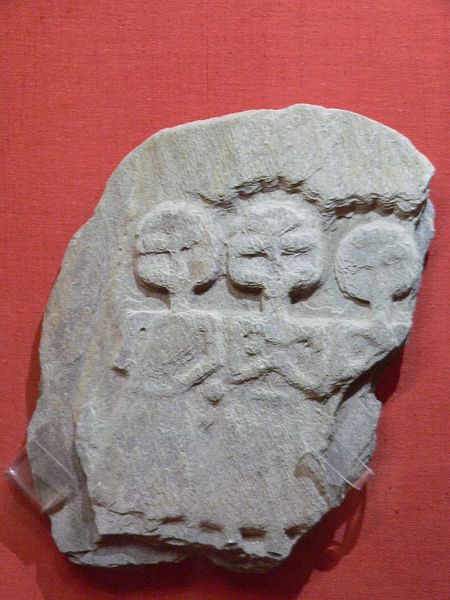
The Mórrigan - a war-goddess whose name likely means 'mare-queen'. Her sisters are the demon war-goddesses Bodb and Macha and trio are sometimes referred to as the Mórrigna. She was important during the festival of Samhain on 31st October/1st November when she coupled with the warrior god the Dagda, which guaranteed fertility and prosperity for the coming year. The Mórrigan features prominently in later Irish mythology where she is repeatedly unsuccessful in her attempts to seduce the hero Cú Chulainn. She was here most associated with inciting conflict, stirring up the frenzy of battle, and as the bringer of death. The goddess has a terrible appearance but she has both sex appeal and associations with fertility, despite her destructive nature on the battlefield where she most often appears as a crow or raven.
Mullo - a god whose name suggests an association with hills or mules. Votive inscriptions naming Mullo have survived at Craon, Nantes, Rennes, and Allones, all in northwest Gaul. He likely had a role as a healing god, in particular, ailments of the eyes.
Nabelcus - a god who is named in several votive inscriptions from Saint-Didier in southeast France. He was associated with Mars by the Romans.
Nantosuelta - a goddess venerated in Roman Gaul who is named in various inscriptions and shown in visual form as a woman holding a sceptre topped by a miniature house. She was likely linked with the home and hearth. She is sometimes mentioned as the consort of Sucellus.
Nehalennia - a goddess venerated on the North Sea coast of England and in the Netherlands. She is often depicted as a young woman wearing a short cape, seated and holding a basket of fruit; she is very often accompanied by a dog.
Neít - a pre-Christian god of war venerated in Ireland. His wife is Nemain.
Nemain - a pre-Christian war goddess venerated in Ireland who was thought to confuse warriors on the battlefield. She is the wife of Neít.
Nemetona - a goddess whose name derives from the Celtic term for a sacred grove of trees (nemeton). Votive inscriptions naming the goddess survive from both England and Germany, some of which indicate she is the partner of Mars. The goddess had temples dedicated to her at Klein-Winternheim and Trier, both in eastern Germany.
Nodons (also Nodens or Nudens) - a god whose name may mean 'fisherman-hunter'. Two votive inscriptions from northwest England (now lost) named the god. Other inscriptions survive from Lydney Park in southwest England. He was associated with healing and dogs. The Romans equated Nodons with their god Mars.
Noreia - a goddess venerated in southern Austria and northern Slovenia.
Ocelus - a god venerated in southern Wales and northwest England as attested by surviving votive inscriptions. The Romans equated Ocelus with their god of war Mars.
Ogmios - a god named in two lead curse tablets from Bregenz in eastern Austria. He was likely associated with the Underworld although the 2nd-century CE Syrian writer Lucian of Samosata equates him with Hercules. Lucian describes having seen a statue of Ogmios in Gaul where he is represented as an old man with dark skin who holds a club and wears a lion pelt. Curiously, this statue was accompanied by people made from amber who were wearing chains, which were attached to Hercules' tongue and ears. On asking what this signified, the Gauls replied that the figure represented eloquence. This attribute was associated with Hermes/Mercury for the Greeks and Romans, but it is notable that in later Irish mythology the invention of writing was credited to a figure called Ogma.
Olloudius - Votive inscriptions naming the god survive from southwest England and southern France. In a surviving figurine from southern England, he is shown wearing a cap and cloak while he holds a plate of offering and a cornucopia (horn of plenty), both suggesting he was associated with healing, fertility, and prosperity. He is identified with Mars by the Romans.
Rhenus - the classical name for the Rhine river which the Celts may have called Rēnos. The river may have been considered a 'father' to those people living near it, an attitude suggested by a votive altar inscription (RHENO PATRI) from Strasbourg in eastern France. In addition, the Roman poet Propertius (c. 50 - c. 15 BCE) describes a 3rd-century BCE Celtic prince by the name of Viridomarus who called himself a descendant of the Rhine.
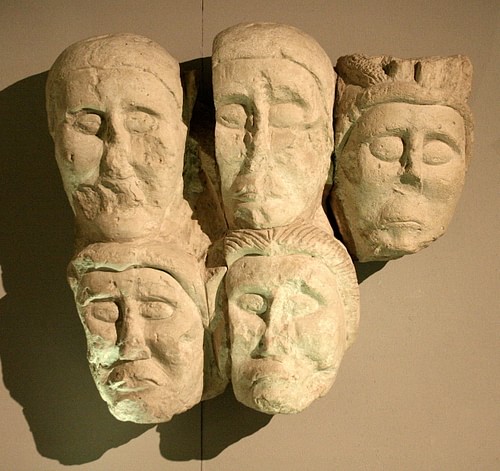
Robur - a god associated with the oak tree.
Rosmerta - a goddess whose name implies a protectress role who was associated with motherhood and fertility. Her usual attributes are a cornucopia (horn of plenty) and a patera (sacrificial bowl). Rosmerta was venerated in northeast Gaul. Her companion god in some votive inscriptions is Mercury, and this explains why she is sometimes depicted holding that god’s staff, the caduceus.
Rudianus - a god venerated in southeast France as attested by votive inscriptions. The Romans identified him with their god of war Mars.
Rudiobus - a god mentioned in a single votive inscription on the base of a horse statue from Neuvy-en-Sullias in central France.
Segomo - a god associated with horses and particularly venerated by the Sequani tribe in central-eastern Gaul as attested by numerous votive inscriptions. The Romans identified the god with Mars.
Sequana - a healing goddess who shares her name with the Celtic name for the River Seine. The goddess had an important sanctuary at the source of the Seine near Dijon where many votive offerings have been excavated including over 200 wooden sculptures. Finds have also included a bronze figurine of the goddess standing in a boat with her arms spread wide. Her shrine was expanded in the Roman period.
Sirona (also Dirona) - a goddess whose name means 'star', she was venerated in various locations across France, Germany, and Austria, most often at healing springs. Sirona is often represented as a woman in a long robe holding grapes, eggs, or an ear of wheat and so she was associated with fertility. She is the most frequent companion of Apollo for the Celts, but she can also be identified as the consort of Grannus.
Smertius (also Smertrios) - a god whose name suggests an association with protection and providence. He appears both in name and as a relief in the Nautae Parisiaci, a 1st-century CE votive column found beneath the cathedral of Notre-Dame in Paris. On the column he is shown as a bearded man holding a club and the tail of a snake which he his about to hit.
Souconna - a goddess who is a personification of the River Saône in eastern France. She is named in various votive inscriptions from the region.
Sucellus (also Succelus or Sucaelus) - a god whose name may mean 'the Good Striker'. He was venerated across Celtic continental Europe as attested by votive inscriptions. His consort is sometimes Nantosuelta, notably on an inscribed altar from Sarrebourg in eastern France. This altar shows a relief of the two gods where Sucellus is bearded, holds a sceptre, and wears a short tunic and boots. Besides the god is a bulbous pot. The sceptre is particular as it is long and topped by what appears to be a hammer. Many other depictions of the god also include this hammer-sceptre, and he frequently has a canine companion.
Suleviae - this is a group of Celtic sister goddesses who were venerated in Britain, Germany, and Rome (where there were many Celtic mercenaries). The trio was most likely seen as protective figures and associated with regeneration.
Sulis - a goddess who is best known (but not exclusively) from the healing spring named after her, the Aquae Sulis, in Bath, England where she also had an impressive temple dedicated to her. Sulis is mentioned by name on many votive altars and curse tablets, as well as a grave marker for one of her priests. The Romans identified the goddess with Minerva.
Sutugius - perhaps a pre-Celtic god, he is mentioned by name in votive inscriptions from near Saint-Placard in southwest France. The Romans equated him with Mars.
Taranis - a god identified with the sky and thunder, as his name suggests, and so he was associated with Jupiter by the Romans. The 1st-century CE Roman poet Lucan noted that human sacrificial victims to Taranis were burnt in a wooden tub. He is mentioned in votive inscriptions where his name is spelt either as Taranucus or Taranucnus.
Tarvos Trigaranus - a god whose name translates as 'the bull with three cranes'. He is both named and depicted on the 1st-century CE votive monument the Nautae Parisiaci, which was discovered beneath the cathedral of Notre-Dame in Paris. As befitting his name, the god is shown as a bull standing by a tree and with three cranes standing on his back. This likely refers to a popular myth concerning the god which has now been lost. A stele from Trier in western Germany also shows a bull with three birds, indicating the myth was widespread in the Celtic world. The myth may also concern the god Esus.
Teutates (also Toutates) - a god whose name may derive from the term 'god of the tribe' or 'father of the tribe'. He is mentioned in votive inscriptions from Britain, Austria, and Rome. The 1st-century CE Roman poet Lucan noted that human sacrificial victims to Teutates were drowned headfirst in a tub of water. The Romans equated him with their god Mars.
Toutiorix - a god whose name may mean 'king of the tribal group'. A votive inscription naming the god survives from Wiesbaden in eastern Germany. The Romans equated the god with Apollo.
Ucuetis - a god who is named in a votive inscription from Alesia in northeast France. Depictions of Ucuetis holding a hammer may indicate he was a patron of craftworkers. His consort is Bergusia according to an inscription found on Mont Auxois at Alesia.
Verbeia - a goddess particularly venerated in northeast England from where a sandstone altar and a relief survive, both from the Roman fort of Ilkley. The relief depicts the goddess holding a snake in each hand.
Vernostonus - a god identified in one inscription with Cocidius who was venerated in northern England and seems to have been especially popular with Roman soldiers.
Veteris (also Vitris or Vitiris) - a god mentioned in a great number of votive inscriptions from northern England.
Vindonnus - a god named in several inscriptions found in Essarois in northeast France. Votive plaques often show eyes so perhaps he was linked to cures for eye ailments. He was equated with Apollo by the Romans, also a healing god.
Visucius - a god venerated across Gaul as indicated by surviving votive inscriptions from Bordeaux and northeast France as well as the Benelux countries. He was equated with Mercury by the Romans.
Vorocius - a god whose name may derive from Voroux in central France. A votive inscription naming the god survives from nearby Vichy and indicates that the Romans equated him with their god Mars.
Vosegus - a god named in several surviving votive inscriptions, it is also the name of the forest region of eastern France where the Vogesen tribe lived. He is depicted carrying a piglet and holding nuts and pinecones.
